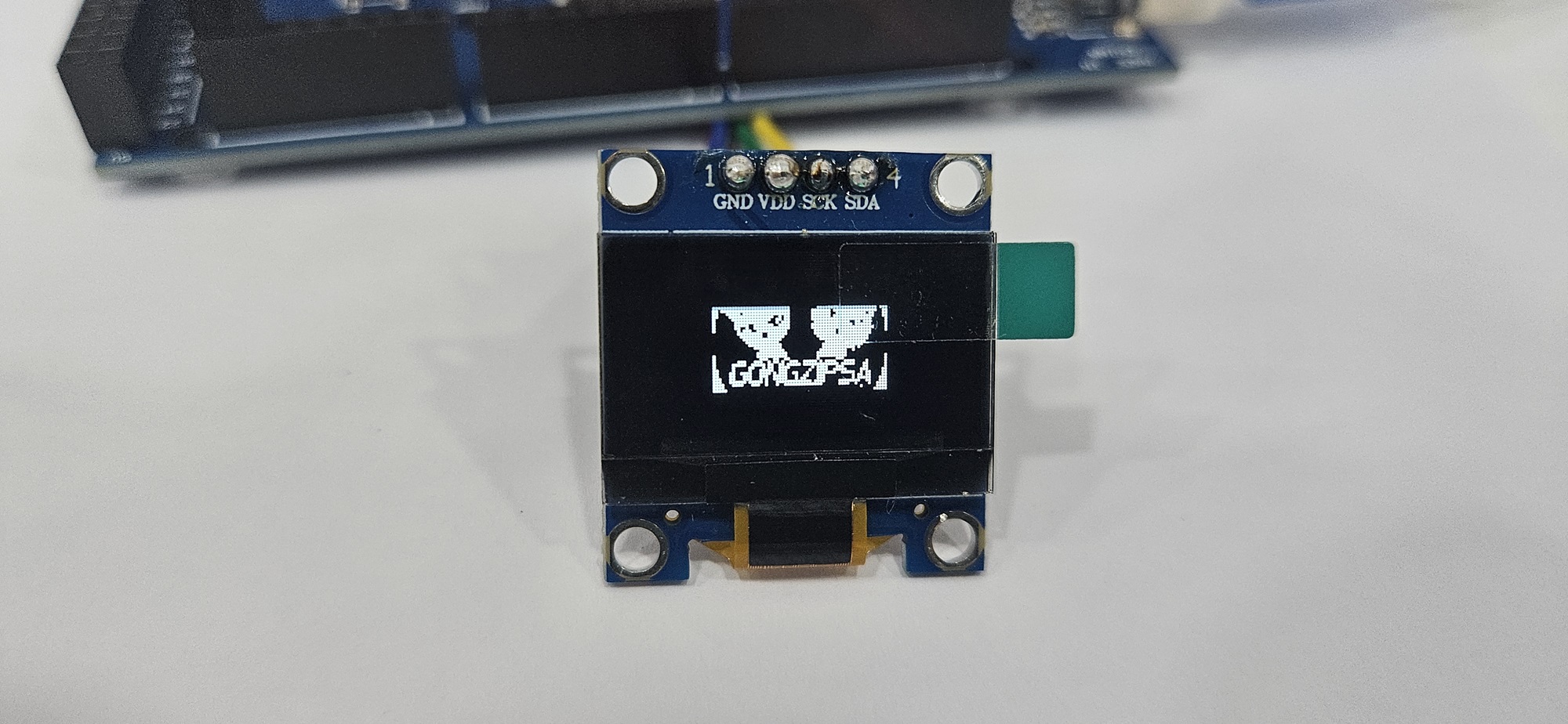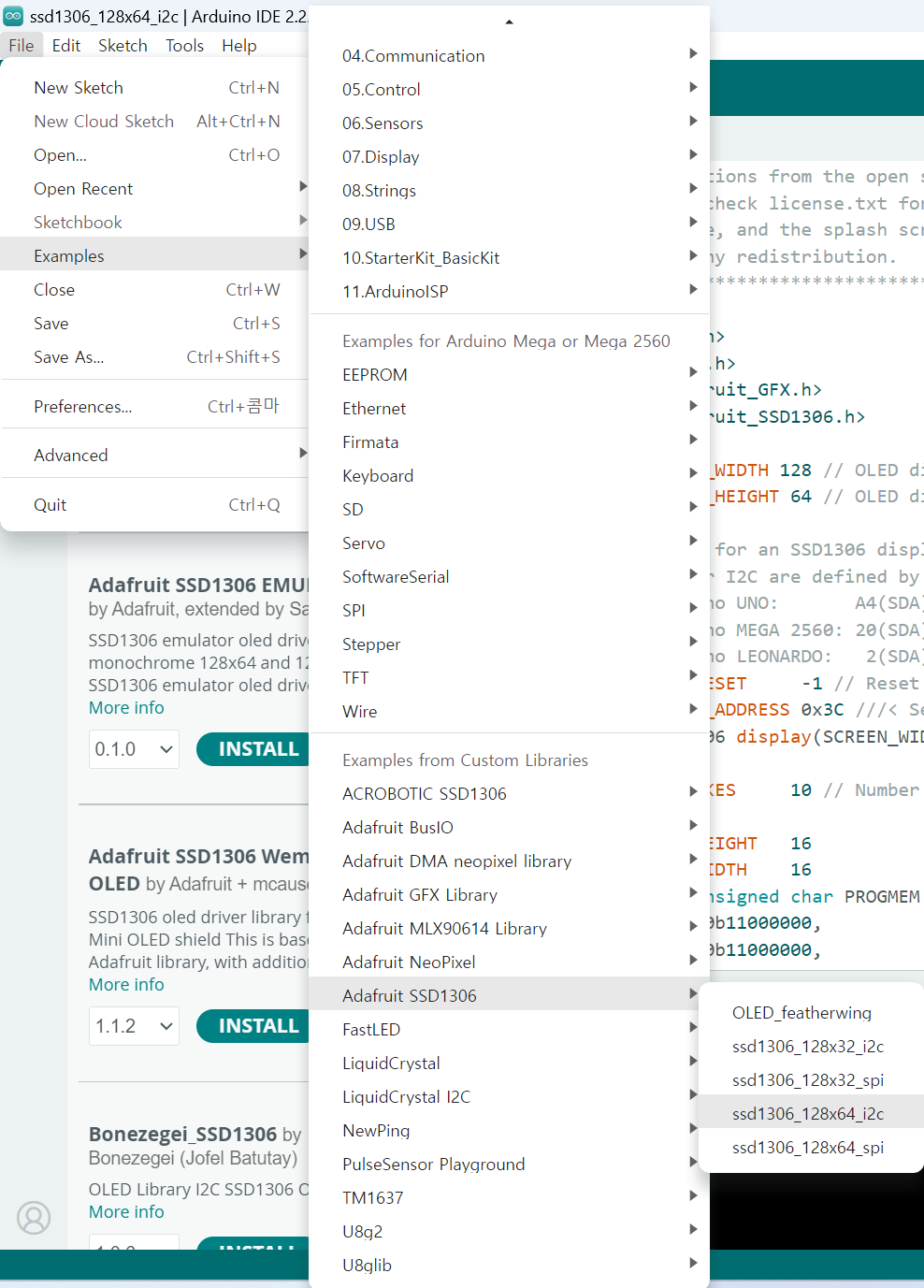I2C OLED Module En: 두 판 사이의 차이
(새 문서: {{#seo:|title=아두위키 : 아두이노 I2C OLED 모듈 가이드|title_mode=append|keywords=아두이노, 정보과학, 메이커학습, 수행평가, I2C OLED 모듈, 아두이노 작품, 캡스톤작품, 아두이노 예제코드|description=아두이노로 I2C OLED 모듈을 제어하는 방법(기본정보, 회로, 예제 코드)을 소개합니다. 정보과학과 메이커수업에 활용가능합니다.}} 가운데|class=coders100 == '''개...) |
잔글편집 요약 없음 |
||
| (같은 사용자의 중간 판 하나는 보이지 않습니다) | |||
| 1번째 줄: | 1번째 줄: | ||
{{#seo:|title= | {{#seo:|title=Arduwiki : Arduino I2C OLED Module Guide|title_mode=append|keywords=Arduino, Information Science, Maker Learning, Performance Assessment, I2C OLED Module, Arduino Project, Capstone Project, Arduino Example Code|description=This introduces how to control a I2C OLED Module with Arduino (basic information, circuit, example code). It can be used in Information Science and Maker classes.}} | ||
[[파일:OLED 사진.jpg|가운데|class=coders100]] | [[파일:OLED 사진.jpg|가운데|class=coders100]] | ||
== ''' | == '''Overview''' == | ||
The Arduino OLED module is a display module with a small size and high resolution, suitable for various projects. Based on OLED (Organic Light Emitting Diode) technology, it provides excellent color and contrast. | |||
=== OLED | === OLED Operating Principle === | ||
'''Organic Material''': OLED contains a thin layer of organic materials that emit light when an electric current passes through. Organic compounds have the property of emitting light when stimulated electrically. | |||
'''Electrodes''': The OLED panel typically consists of two electrodes (anode and cathode). When electricity flows, the organic material releases electrons, and these electrons combine with holes to generate light. | |||
=== SSD1306 === | === SSD1306 === | ||
The SSD1306 is a driver IC (integrated circuit) used to control OLED displays. | |||
It contains 1KB of dedicated RAM for graphic display (GDDRAM), which is used to store the bit patterns to be displayed. | |||
[[파일:SSD1306 구조.jpg|가운데|class=coders100]] | [[파일:SSD1306 구조.jpg|가운데|class=coders100]] | ||
{| class="wikitable" | {| class="wikitable" | ||
! | !List | ||
! | !Explanation | ||
|- | |- | ||
|''' | |'''Memory capacity''' | ||
|1KB ( | |1KB (8192bit) | ||
|- | |- | ||
|''' | |'''Number of Page''' | ||
|8 | |8 page (Page 0-7) | ||
|- | |- | ||
|''' | |'''Number of lines arranged vertically''' | ||
|128 | |128 vertical lines (vertical line 0-127) | ||
|- | |- | ||
|''' | |'''Bit Information''' | ||
| | |8 bits per vertical line (bits 0-7) | ||
|- | |- | ||
|''' | |'''Calculation''' | ||
|8 | |8 pages x 128 vertical lines x 8 bits = 8192 bits = 1024 bytes (1KB) | ||
|} | |} | ||
== ''' | == '''Specification''' == | ||
{| class="wikitable" | {| class="wikitable" | ||
! | !List | ||
! | !Explanation | ||
|- | |- | ||
|''' | |'''Display Size''' | ||
|0. | |Various sizes such as 0.91inch, 0.96inch, 1.3inch, 2.42inch | ||
|- | |- | ||
|''' | |'''Resolution''' | ||
|128x64 | |128x64 pixels or 128x32 pixels | ||
|- | |- | ||
|''' | |'''Display Type''' | ||
|OLED (Organic Light Emitting Diode) | |OLED (Organic Light Emitting Diode) | ||
|- | |- | ||
|''' | |'''Color''' | ||
| | |Black and White (White or Blue) | ||
|- | |- | ||
|''' | |'''Interface''' | ||
|I2C ( | |I2C (2 pins) | ||
|- | |- | ||
|''' | |'''Voltage''' | ||
|3.3V ~ 5V | |3.3V ~ 5V | ||
|- | |- | ||
|''' | |'''Power Consumption''' | ||
| | |Standby Power: About 0.1mA, Maximum Power: About 20mA | ||
|} | |} | ||
== ''' | == '''Application Examples''' == | ||
=== | === Circuit Configuration === | ||
{| class="wikitable" | {| class="wikitable" | ||
!OLED | !OLED module pin | ||
! | !Arduino Uno/Nano | ||
! | !Arduino Mega | ||
|- | |- | ||
|VCC | |VCC | ||
|5V | |5V or 3.3V | ||
|5V | |5V or 3.3V | ||
|- | |- | ||
|GND | |GND | ||
| 95번째 줄: | 94번째 줄: | ||
[[파일:OLED회로.jpg|가운데|class=coders100]] | [[파일:OLED회로.jpg|가운데|class=coders100]] | ||
=== | === Device Address Verification === | ||
I2C | |||
This is the code used to find the address of devices connected to the I2C bus. | |||
Before running the examples introduced below, please run the I2C Scanner first to check the address of the module.<syntaxhighlight lang="c++" line="1"> | |||
#include <Wire.h> | #include <Wire.h> | ||
void setup() { | void setup() { | ||
Serial.begin(9600); | Serial.begin(9600); | ||
Wire.begin(); | Wire.begin(); | ||
Serial.println("I2C Scanner | Serial.println("I2C Scanner Start..."); | ||
} | } | ||
| 111번째 줄: | 111번째 줄: | ||
int nDevices = 0; | int nDevices = 0; | ||
Serial.println("I2C | Serial.println("I2C Device Scanning..."); | ||
for (address = 1; address < 127; address++) { | for (address = 1; address < 127; address++) { | ||
// I2C | // Attempting to connect to the I2C device | ||
Wire.beginTransmission(address); | Wire.beginTransmission(address); | ||
error = Wire.endTransmission(); | error = Wire.endTransmission(); | ||
if (error == 0) { | if (error == 0) { | ||
Serial.print(" | Serial.print("Device found! Address: 0x"); | ||
if (address < 16) { | if (address < 16) { | ||
Serial.print("0"); | Serial.print("0"); | ||
| 127번째 줄: | 127번째 줄: | ||
nDevices++; | nDevices++; | ||
} else if (error == 4) { | } else if (error == 4) { | ||
Serial.print(" | Serial.print("Address 0x"); | ||
Serial.print(address, HEX); | Serial.print(address, HEX); | ||
Serial.println(" | Serial.println("error occurred!"); | ||
} | } | ||
} | } | ||
if (nDevices == 0) { | if (nDevices == 0) { | ||
Serial.println("I2C | Serial.println("No I2C device found."); | ||
} else { | } else { | ||
Serial.println(" | Serial.println("Device scanning complete."); | ||
} | } | ||
delay(5000); // | delay(5000); // Wait for 5 seconds before scanning again. | ||
} | } | ||
</syntaxhighlight> | </syntaxhighlight> | ||
| 148번째 줄: | 148번째 줄: | ||
=== | === Library === | ||
Adafruit SSD1306 | Please use the Adafruit SSD1306 library. | ||
SSD1306 | When installing SSD1306, please also click INSTALL ALL to install the required Adafruit BusIO and Adafruit GFX Library together. | ||
[[파일:OLED라이브러리설치.jpg|가운데|class=coders100]] | [[파일:OLED라이브러리설치.jpg|가운데|class=coders100]] | ||
=== 1. | === 1. Library Default Examples === | ||
File - Examples - Adafruit SSD1306 - ssd1306_128x64 i2c | |||
Click on File - Examples - Adafruit SSD1306 - ssd1306_128x64 i2c to open the example. | |||
[[파일:OLED라이브러리기본제공예제.png|class=coders50]] | [[파일:OLED라이브러리기본제공예제.png|class=coders50]] | ||
| 163번째 줄: | 164번째 줄: | ||
Please change the Address part in the example code to the device address confirmed earlier with the I2C Scanner. | |||
[[파일:OLED장치주소수정.jpg|가운데|class=coders100]] | [[파일:OLED장치주소수정.jpg|가운데|class=coders100]] | ||
| 169번째 줄: | 170번째 줄: | ||
==== | ==== Execution Result ==== | ||
<div class="coders70"> | <div class="coders70"> | ||
<youtube> LFLyyKAffCI </youtube> | <youtube> LFLyyKAffCI </youtube> | ||
| 175번째 줄: | 176번째 줄: | ||
=== 2. | === 2. Text Output === | ||
This is an example of printing simple text. | |||
0. | I used a 0.91-inch OLED, and since this module has a resolution of 128 x 32 pixels, I changed the 6th line SCREEN_HEIGHT from 64 to 32. | ||
<syntaxhighlight lang="c++" line="1"> | |||
#include <Wire.h> | #include <Wire.h> | ||
#include <Adafruit_GFX.h> | #include <Adafruit_GFX.h> | ||
#include <Adafruit_SSD1306.h> | #include <Adafruit_SSD1306.h> | ||
#define SCREEN_WIDTH 128 // OLED | #define SCREEN_WIDTH 128 // OLED width | ||
#define SCREEN_HEIGHT 32 // OLED | #define SCREEN_HEIGHT 32 // OLED height | ||
// OLED | // I2C address of the OLED module (typically 0x3D or 0x3C) | ||
#define OLED_ADDR 0x3C | #define OLED_ADDR 0x3C | ||
// Adafruit_SSD1306 | // Create Adafruit_SSD1306 object | ||
Adafruit_SSD1306 display(SCREEN_WIDTH, SCREEN_HEIGHT, &Wire, -1); | Adafruit_SSD1306 display(SCREEN_WIDTH, SCREEN_HEIGHT, &Wire, -1); | ||
void setup() { | void setup() { | ||
// OLED | // OLED Initialization | ||
display.begin(SSD1306_SWITCHCAPVCC, OLED_ADDR); | display.begin(SSD1306_SWITCHCAPVCC, OLED_ADDR); | ||
display.clearDisplay(); // | display.clearDisplay(); // Clear the screen | ||
display.setTextSize(1); // | display.setTextSize(1); // Set text size | ||
display.setTextColor(SSD1306_WHITE); // | display.setTextColor(SSD1306_WHITE); // Set text color | ||
display.setCursor(0, 0); // | display.setCursor(0, 0); // Set cursor position | ||
display.println("GONGZIPSA"); // | display.println("GONGZIPSA"); // Print text | ||
display.setCursor(0, 10); // | display.setCursor(0, 10); // Set cursor position | ||
display.println("ArduWiki"); // | display.println("ArduWiki"); // Print text | ||
display.display(); // | display.display(); // Display on the screen | ||
} | } | ||
void loop() { | void loop() { | ||
} | } | ||
</syntaxhighlight> | </syntaxhighlight> | ||
| 212번째 줄: | 214번째 줄: | ||
The roles of the used functions are as follows. | |||
{| class="wikitable" | {| class="wikitable" | ||
! | !Functions | ||
! | !Explanation | ||
|- | |- | ||
|<code>begin()</code> | |<code>begin()</code> | ||
|OLED | |Initializes the OLED display. Sets the I2C address and resolution. | ||
|- | |- | ||
|<code>clearDisplay()</code> | |<code>clearDisplay()</code> | ||
| | |Clears the current content of the display. Initializes the screen. | ||
|- | |- | ||
|<code>setTextSize(size)</code> | |<code>setTextSize(size)</code> | ||
| | |Sets the size of the text to be displayed. The <code>size</code> indicates the scale. (e.g., 1, 2, etc.) | ||
|- | |- | ||
|<code>setTextColor(color)</code> | |<code>setTextColor(color)</code> | ||
| | |Sets the color of the text. Typically, <code>SSD1306_WHITE</code> and <code>SSD1306_BLACK</code> are used. | ||
|- | |- | ||
|<code>setCursor(x, y)</code> | |<code>setCursor(x, y)</code> | ||
| | |Sets the position where the text will be displayed. <code>x</code> is the horizontal position, and <code>y</code> is the vertical position. | ||
(0, 0) | |||
(0, 0) is the top-left corner, and as <code>x</code> increases, it moves to the right, while increasing <code>y</code> moves it downward. | |||
|- | |- | ||
|println(" | |println("Contents") | ||
| | |Sets the content to be displayed. | ||
|- | |- | ||
|<code>display()</code> | |<code>display()</code> | ||
| | |Outputs the content stored in the buffer to the OLED display. | ||
|} | |} | ||
==== | ==== Execution Result ==== | ||
[[파일:OLED예제2실행결과.jpg|가운데|class=coders100]] | [[파일:OLED예제2실행결과.jpg|가운데|class=coders100]] | ||
=== 3. | === 3. Simple Shape Output === | ||
This is an example of outputting simple shapes such as rectangles, triangles, and circles.<syntaxhighlight lang="c++" line="1"> | |||
#include <Wire.h> | #include <Wire.h> | ||
#include <Adafruit_GFX.h> | #include <Adafruit_GFX.h> | ||
| 259번째 줄: | 263번째 줄: | ||
void setup() { | void setup() { | ||
display.begin(SSD1306_SWITCHCAPVCC, OLED_ADDR); | display.begin(SSD1306_SWITCHCAPVCC, OLED_ADDR); | ||
display.clearDisplay(); // | display.clearDisplay(); // Clear the screen | ||
display.drawTriangle(10, 10, 40, 30, 10, 30, WHITE); // | display.drawTriangle(10, 10, 40, 30, 10, 30, WHITE); // Draw a small triangle | ||
display.drawRect(50, 10, 30, 20, WHITE); // | display.drawRect(50, 10, 30, 20, WHITE); // Draw a rectangle | ||
display.fillRect(90, 10, 30, 20, WHITE); // | display.fillRect(90, 10, 30, 20, WHITE); // Draw a filled rectangle | ||
display.drawCircle(25, 50, 13, WHITE); // | display.drawCircle(25, 50, 13, WHITE); // Draw a circle | ||
display.drawRoundRect(50, 40, 30, 20, 7, WHITE); // | display.drawRoundRect(50, 40, 30, 20, 7, WHITE); // Draw a rounded rectangle | ||
display.fillRoundRect(90, 40, 30, 20, 7, WHITE); // | display.fillRoundRect(90, 40, 30, 20, 7, WHITE); // Draw a filled rounded rectangle | ||
display.display(); | display.display(); // Display the shapes | ||
} | } | ||
| 275번째 줄: | 279번째 줄: | ||
The functions related to shapes are as follows: | |||
{| class="wikitable" | {| class="wikitable" | ||
! | !Functions | ||
! | !Explanation | ||
|- | |- | ||
|<code>drawLine(x1, y1, x2, y2, color)</code> | |<code>drawLine(x1, y1, x2, y2, color)</code> | ||
| | |Draws a line connecting two points. | ||
|- | |- | ||
|<code>drawRect(x, y, width, height, color)</code> | |<code>drawRect(x, y, width, height, color)</code> | ||
| | |Draws an empty rectangle. | ||
|- | |- | ||
|<code>fillRect(x, y, width, height, color)</code> | |<code>fillRect(x, y, width, height, color)</code> | ||
| | |Draws a filled rectangle. | ||
|- | |- | ||
|<code>drawCircle(x, y, radius, color)</code> | |<code>drawCircle(x, y, radius, color)</code> | ||
| | |Draws an empty circle. | ||
|- | |- | ||
|<code>fillCircle(x, y, radius, color)</code> | |<code>fillCircle(x, y, radius, color)</code> | ||
| | |Draws a filled circle. | ||
|- | |- | ||
|<code>drawTriangle(x1, y1, x2, y2, x3, y3, color)</code> | |<code>drawTriangle(x1, y1, x2, y2, x3, y3, color)</code> | ||
| | |Draws a triangle | ||
|- | |- | ||
|<code>drawRoundRect(x, y, width, height, radius, color)</code> | |<code>drawRoundRect(x, y, width, height, radius, color)</code> | ||
| | |Draws an empty rectangle with rounded corners. | ||
|- | |- | ||
|<code>fillRoundRect(x, y, width, height, radius, color)</code> | |<code>fillRoundRect(x, y, width, height, radius, color)</code> | ||
| | |Draws a filled rectangle with rounded corners. | ||
|} | |} | ||
==== | ==== Execution Result ==== | ||
[[파일:OLED예제3실행결과.jpg|가운데|class=coders100]] | [[파일:OLED예제3실행결과.jpg|가운데|class=coders100]] | ||
=== 4. | === 4. ASCII Code Output === | ||
This is an example of outputting characters corresponding to ASCII codes 1 to 8. | |||
For more characters, please refer to the ASCII code table.<syntaxhighlight lang="c++" line="1"> | |||
#include <Wire.h> | #include <Wire.h> | ||
#include <Adafruit_GFX.h> | #include <Adafruit_GFX.h> | ||
| 327번째 줄: | 331번째 줄: | ||
void setup() { | void setup() { | ||
display.begin(SSD1306_SWITCHCAPVCC, OLED_ADDR); | display.begin(SSD1306_SWITCHCAPVCC, OLED_ADDR); | ||
display.clearDisplay(); // | display.clearDisplay(); // Clear the screen | ||
// | // Text output settings | ||
display.setTextSize(1); // | display.setTextSize(1); // Set text size | ||
display.setTextColor(WHITE); // | display.setTextColor(WHITE); // Set text color | ||
display.setCursor(0, 0); // | display.setCursor(0, 0); // Set cursor position | ||
// | // Print ASCII code characters | ||
display.println("ASCII Code Print"); | display.println("ASCII Code Print"); | ||
// | // Print ASCII code characters | ||
for (char c = 1; c < 9; c++) { // | for (char c = 1; c < 9; c++) { // From ASCII code 1 to 8 | ||
display.print(c); // Print each character | |||
display.print(" "); // Add space | |||
} | } | ||
display.display(); // | display.display(); // Display the buffer content on the screen | ||
} | } | ||
void loop() { | void loop() { | ||
} | } | ||
</syntaxhighlight> | </syntaxhighlight> | ||
==== | ==== Execution Result ==== | ||
[[파일:OLED예제4아스키코드출력.jpg|가운데|class=coders100]] | [[파일:OLED예제4아스키코드출력.jpg|가운데|class=coders100]] | ||
=== 5. | === 5. Bitmap Image Output === | ||
This is an example of outputting an image on the OLED by converting it into a byte array. | |||
==== How to Convert an Image to a Byte Array ==== | |||
1. Go to [https://javl.github.io/image2cpp/ image2cpp (javl.github.io)]. | |||
2. '''Upload Image''' | |||
Select a file to upload from the left-side Select image. | |||
[[파일:Img2cpp이미지업로드.png|가운데|class=coders100]] | [[파일:Img2cpp이미지업로드.png|가운데|class=coders100]] | ||
''' | 3. '''Image Settings''' | ||
Canvas | Enter the image size in the Canvas size field and check the Preview. If the image is too large and the Canvas size is not properly adjusted, the image may not display correctly in the Preview. | ||
[[파일:Img2cpp이미지세팅.png|가운데|class=coders100]] | [[파일:Img2cpp이미지세팅.png|가운데|class=coders100]] | ||
| 377번째 줄: | 381번째 줄: | ||
'''4. | '''4. Output''' | ||
Code output | Set the Code output format to Arduino Code and click Generate code. The array will be displayed below. | ||
Copy the output array and use it in the example code. | |||
[[파일:Img2cpp출력.png|가운데|class=coders100]] | [[파일:Img2cpp출력.png|가운데|class=coders100]] | ||
==== | ==== Code ==== | ||
<code>drawBitmap(x, y, bitmap, width, height, color)</code> | You can use the <code>drawBitmap(x, y, bitmap, width, height, color)</code> function to draw a bitmap image at a specified position. | ||
<code>color</code> | The <code>color</code> is set to white, so the image will be displayed in white. | ||
Change the const unsigned char ~ part on line 12 to the byte array you created above. | |||
If the example image (64 x 64 size) is different in size, you will need to adjust the x and y cursor positions, as well as the width and height values in the drawBitmap function on line 56 to match the image size. | |||
<syntaxhighlight lang="c++" line="1"> | |||
#include <Wire.h> | #include <Wire.h> | ||
#include <Adafruit_GFX.h> | #include <Adafruit_GFX.h> | ||
| 443번째 줄: | 448번째 줄: | ||
void setup() { | void setup() { | ||
display.begin(SSD1306_SWITCHCAPVCC, OLED_ADDR); | display.begin(SSD1306_SWITCHCAPVCC, OLED_ADDR); | ||
display.clearDisplay(); // | display.clearDisplay(); // Screen initialization | ||
} | } | ||
void loop() { | void loop() { | ||
display.clearDisplay(); // | display.clearDisplay(); // Clear the screen | ||
// 64x64 | // Drawing a 64x64 bitmap image | ||
display.drawBitmap(32, 0, GONGZIPSA, 64, 64, WHITE); // (x, y, bitmap, width, height, color) | display.drawBitmap(32, 0, GONGZIPSA, 64, 64, WHITE); // (x, y, bitmap, width, height, color) | ||
display.display(); // | display.display(); // Output the buffer contents to the screen | ||
} | } | ||
</syntaxhighlight> | </syntaxhighlight> | ||
==== | ==== Execution Result ==== | ||
Due to flickering, the image appears cut off when captured, but in reality, the round logo is displayed clearly. | |||
[[파일:OLED예제5비트맵이미지출력.jpg|가운데|class=coders100]] | [[파일:OLED예제5비트맵이미지출력.jpg|가운데|class=coders100]] | ||
2025년 3월 27일 (목) 19:52 기준 최신판
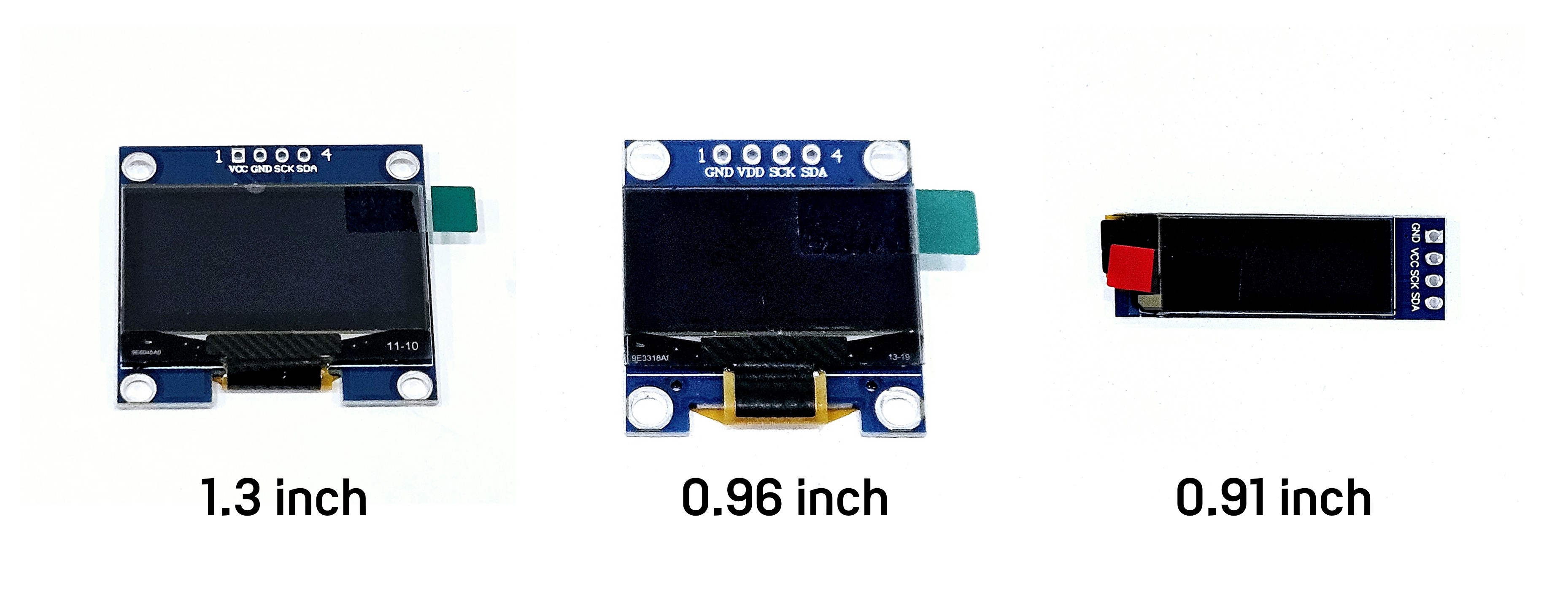
Overview
The Arduino OLED module is a display module with a small size and high resolution, suitable for various projects. Based on OLED (Organic Light Emitting Diode) technology, it provides excellent color and contrast.
OLED Operating Principle
Organic Material: OLED contains a thin layer of organic materials that emit light when an electric current passes through. Organic compounds have the property of emitting light when stimulated electrically. Electrodes: The OLED panel typically consists of two electrodes (anode and cathode). When electricity flows, the organic material releases electrons, and these electrons combine with holes to generate light.
SSD1306
The SSD1306 is a driver IC (integrated circuit) used to control OLED displays.
It contains 1KB of dedicated RAM for graphic display (GDDRAM), which is used to store the bit patterns to be displayed.
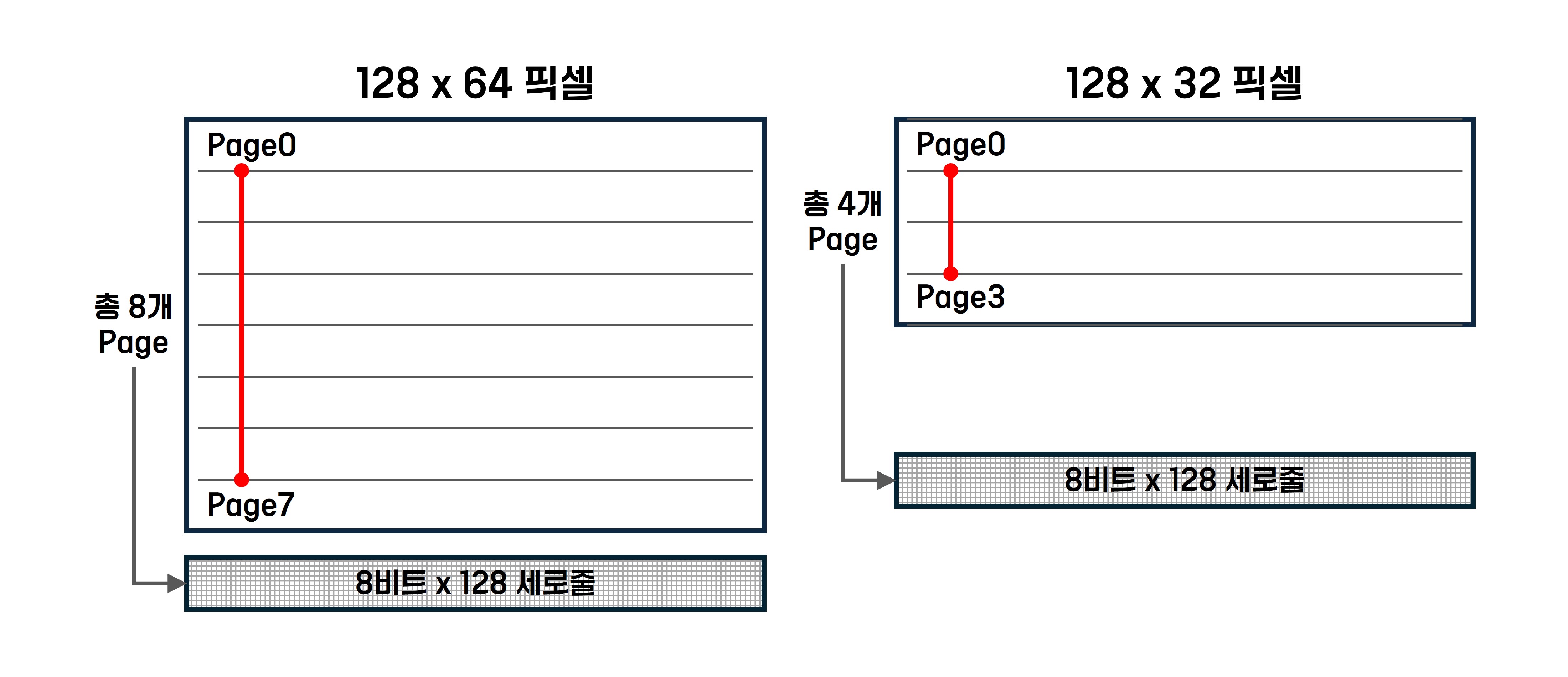
| List | Explanation |
|---|---|
| Memory capacity | 1KB (8192bit) |
| Number of Page | 8 page (Page 0-7) |
| Number of lines arranged vertically | 128 vertical lines (vertical line 0-127) |
| Bit Information | 8 bits per vertical line (bits 0-7) |
| Calculation | 8 pages x 128 vertical lines x 8 bits = 8192 bits = 1024 bytes (1KB) |
Specification
| List | Explanation |
|---|---|
| Display Size | Various sizes such as 0.91inch, 0.96inch, 1.3inch, 2.42inch |
| Resolution | 128x64 pixels or 128x32 pixels |
| Display Type | OLED (Organic Light Emitting Diode) |
| Color | Black and White (White or Blue) |
| Interface | I2C (2 pins) |
| Voltage | 3.3V ~ 5V |
| Power Consumption | Standby Power: About 0.1mA, Maximum Power: About 20mA |
Application Examples
Circuit Configuration
| OLED module pin | Arduino Uno/Nano | Arduino Mega |
|---|---|---|
| VCC | 5V or 3.3V | 5V or 3.3V |
| GND | GND | GND |
| SCL | A5 | 21 |
| SDA | A4 | 22 |
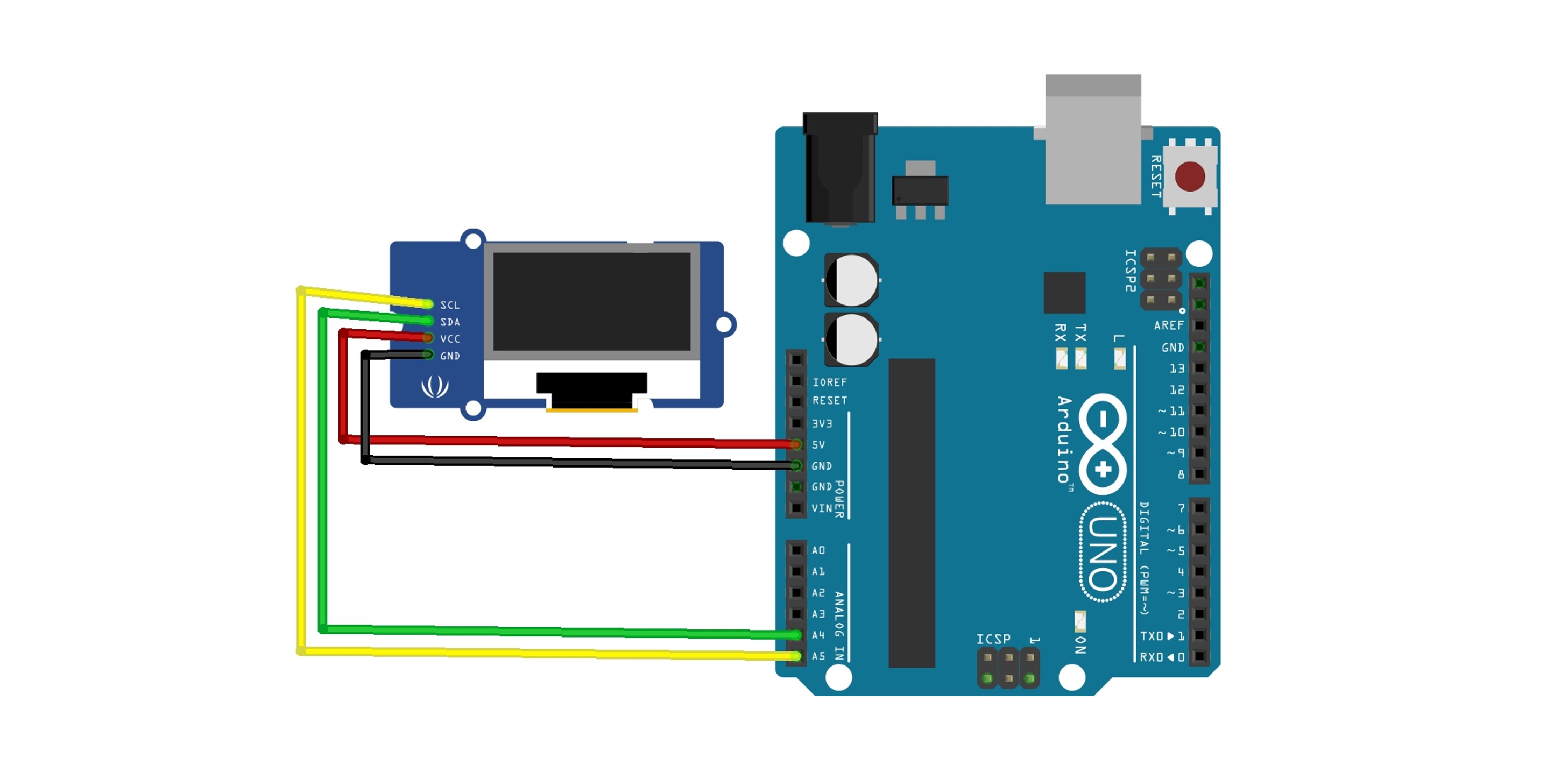
Device Address Verification
This is the code used to find the address of devices connected to the I2C bus.
Before running the examples introduced below, please run the I2C Scanner first to check the address of the module.
#include <Wire.h>
void setup() {
Serial.begin(9600);
Wire.begin();
Serial.println("I2C Scanner Start...");
}
void loop() {
byte error, address;
int nDevices = 0;
Serial.println("I2C Device Scanning...");
for (address = 1; address < 127; address++) {
// Attempting to connect to the I2C device
Wire.beginTransmission(address);
error = Wire.endTransmission();
if (error == 0) {
Serial.print("Device found! Address: 0x");
if (address < 16) {
Serial.print("0");
}
Serial.print(address, HEX);
Serial.println();
nDevices++;
} else if (error == 4) {
Serial.print("Address 0x");
Serial.print(address, HEX);
Serial.println("error occurred!");
}
}
if (nDevices == 0) {
Serial.println("No I2C device found.");
} else {
Serial.println("Device scanning complete.");
}
delay(5000); // Wait for 5 seconds before scanning again.
}
실행 결과

Library
Please use the Adafruit SSD1306 library.
When installing SSD1306, please also click INSTALL ALL to install the required Adafruit BusIO and Adafruit GFX Library together.

1. Library Default Examples
Click on File - Examples - Adafruit SSD1306 - ssd1306_128x64 i2c to open the example.
Please change the Address part in the example code to the device address confirmed earlier with the I2C Scanner.

Execution Result
2. Text Output
This is an example of printing simple text.
I used a 0.91-inch OLED, and since this module has a resolution of 128 x 32 pixels, I changed the 6th line SCREEN_HEIGHT from 64 to 32.
#include <Wire.h>
#include <Adafruit_GFX.h>
#include <Adafruit_SSD1306.h>
#define SCREEN_WIDTH 128 // OLED width
#define SCREEN_HEIGHT 32 // OLED height
// I2C address of the OLED module (typically 0x3D or 0x3C)
#define OLED_ADDR 0x3C
// Create Adafruit_SSD1306 object
Adafruit_SSD1306 display(SCREEN_WIDTH, SCREEN_HEIGHT, &Wire, -1);
void setup() {
// OLED Initialization
display.begin(SSD1306_SWITCHCAPVCC, OLED_ADDR);
display.clearDisplay(); // Clear the screen
display.setTextSize(1); // Set text size
display.setTextColor(SSD1306_WHITE); // Set text color
display.setCursor(0, 0); // Set cursor position
display.println("GONGZIPSA"); // Print text
display.setCursor(0, 10); // Set cursor position
display.println("ArduWiki"); // Print text
display.display(); // Display on the screen
}
void loop() {
}
The roles of the used functions are as follows.
| Functions | Explanation |
|---|---|
begin()
|
Initializes the OLED display. Sets the I2C address and resolution. |
clearDisplay()
|
Clears the current content of the display. Initializes the screen. |
setTextSize(size)
|
Sets the size of the text to be displayed. The size indicates the scale. (e.g., 1, 2, etc.)
|
setTextColor(color)
|
Sets the color of the text. Typically, SSD1306_WHITE and SSD1306_BLACK are used.
|
setCursor(x, y)
|
Sets the position where the text will be displayed. x is the horizontal position, and y is the vertical position.
(0, 0) is the top-left corner, and as |
| println("Contents") | Sets the content to be displayed. |
display()
|
Outputs the content stored in the buffer to the OLED display. |
Execution Result
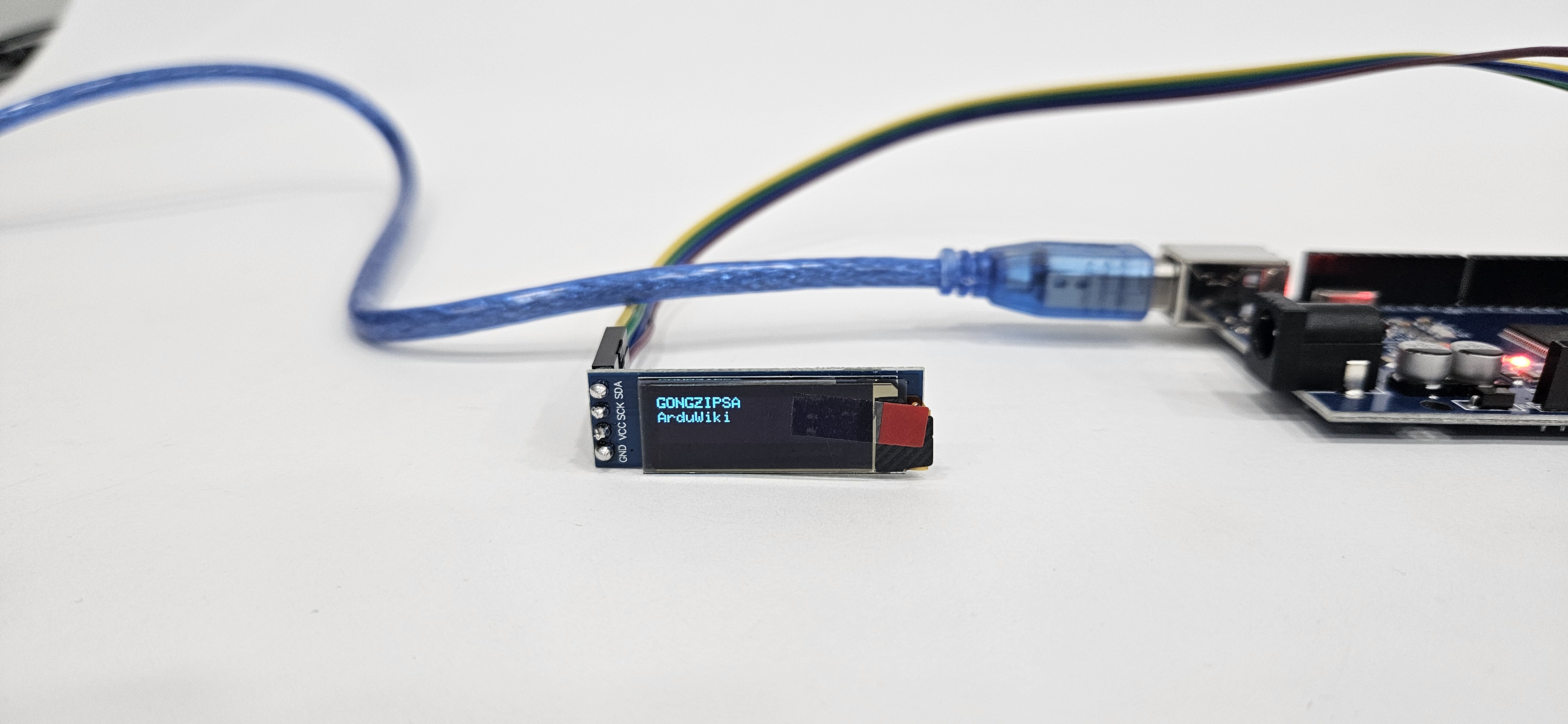
3. Simple Shape Output
This is an example of outputting simple shapes such as rectangles, triangles, and circles.
#include <Wire.h>
#include <Adafruit_GFX.h>
#include <Adafruit_SSD1306.h>
#define SCREEN_WIDTH 128
#define SCREEN_HEIGHT 64
#define OLED_ADDR 0x3C
Adafruit_SSD1306 display(SCREEN_WIDTH, SCREEN_HEIGHT, &Wire, -1);
void setup() {
display.begin(SSD1306_SWITCHCAPVCC, OLED_ADDR);
display.clearDisplay(); // Clear the screen
display.drawTriangle(10, 10, 40, 30, 10, 30, WHITE); // Draw a small triangle
display.drawRect(50, 10, 30, 20, WHITE); // Draw a rectangle
display.fillRect(90, 10, 30, 20, WHITE); // Draw a filled rectangle
display.drawCircle(25, 50, 13, WHITE); // Draw a circle
display.drawRoundRect(50, 40, 30, 20, 7, WHITE); // Draw a rounded rectangle
display.fillRoundRect(90, 40, 30, 20, 7, WHITE); // Draw a filled rounded rectangle
display.display(); // Display the shapes
}
void loop() {
}
The functions related to shapes are as follows:
| Functions | Explanation |
|---|---|
drawLine(x1, y1, x2, y2, color)
|
Draws a line connecting two points. |
drawRect(x, y, width, height, color)
|
Draws an empty rectangle. |
fillRect(x, y, width, height, color)
|
Draws a filled rectangle. |
drawCircle(x, y, radius, color)
|
Draws an empty circle. |
fillCircle(x, y, radius, color)
|
Draws a filled circle. |
drawTriangle(x1, y1, x2, y2, x3, y3, color)
|
Draws a triangle |
drawRoundRect(x, y, width, height, radius, color)
|
Draws an empty rectangle with rounded corners. |
fillRoundRect(x, y, width, height, radius, color)
|
Draws a filled rectangle with rounded corners. |
Execution Result
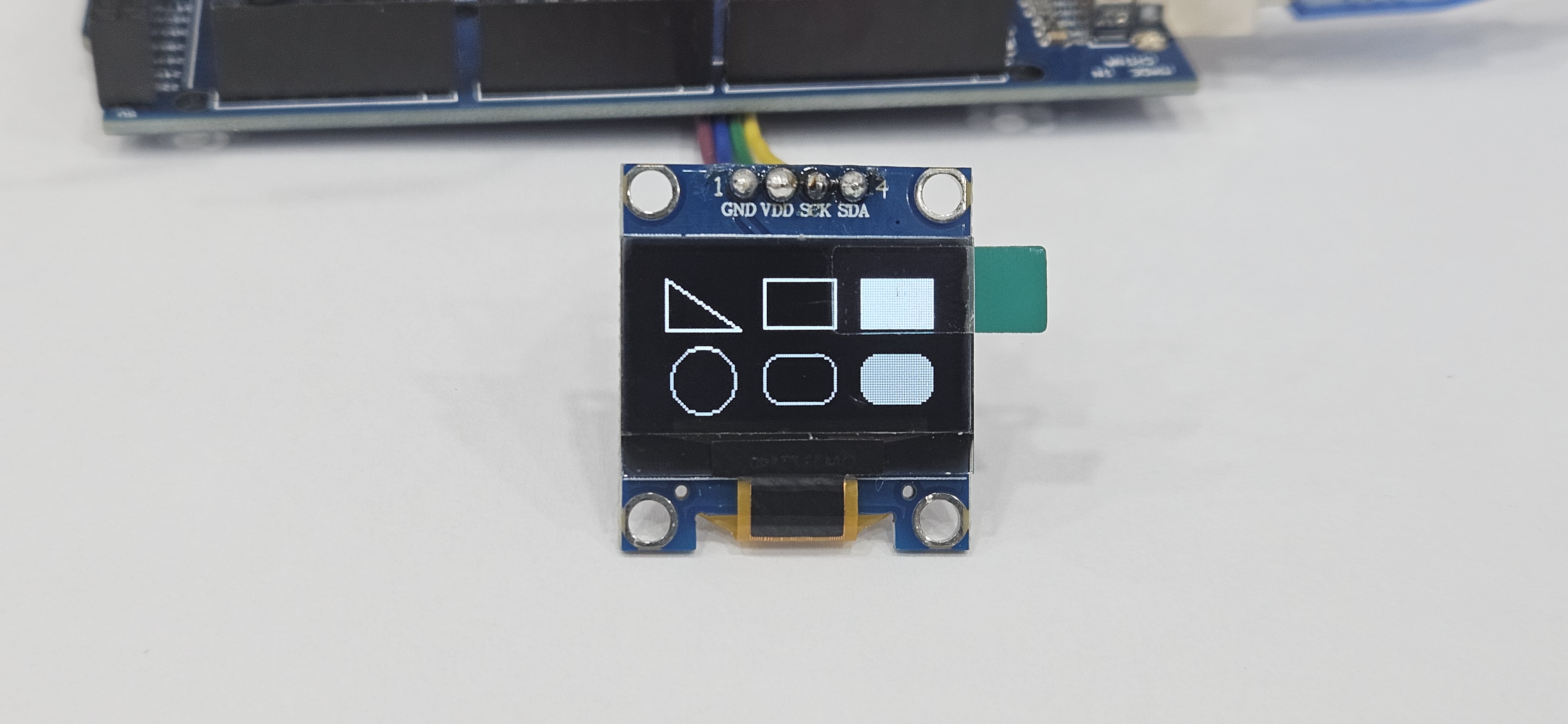
4. ASCII Code Output
This is an example of outputting characters corresponding to ASCII codes 1 to 8.
For more characters, please refer to the ASCII code table.
#include <Wire.h>
#include <Adafruit_GFX.h>
#include <Adafruit_SSD1306.h>
#define SCREEN_WIDTH 128
#define SCREEN_HEIGHT 64
#define OLED_ADDR 0x3C
Adafruit_SSD1306 display(SCREEN_WIDTH, SCREEN_HEIGHT, &Wire, -1);
void setup() {
display.begin(SSD1306_SWITCHCAPVCC, OLED_ADDR);
display.clearDisplay(); // Clear the screen
// Text output settings
display.setTextSize(1); // Set text size
display.setTextColor(WHITE); // Set text color
display.setCursor(0, 0); // Set cursor position
// Print ASCII code characters
display.println("ASCII Code Print");
// Print ASCII code characters
for (char c = 1; c < 9; c++) { // From ASCII code 1 to 8
display.print(c); // Print each character
display.print(" "); // Add space
}
display.display(); // Display the buffer content on the screen
}
void loop() {
}
Execution Result
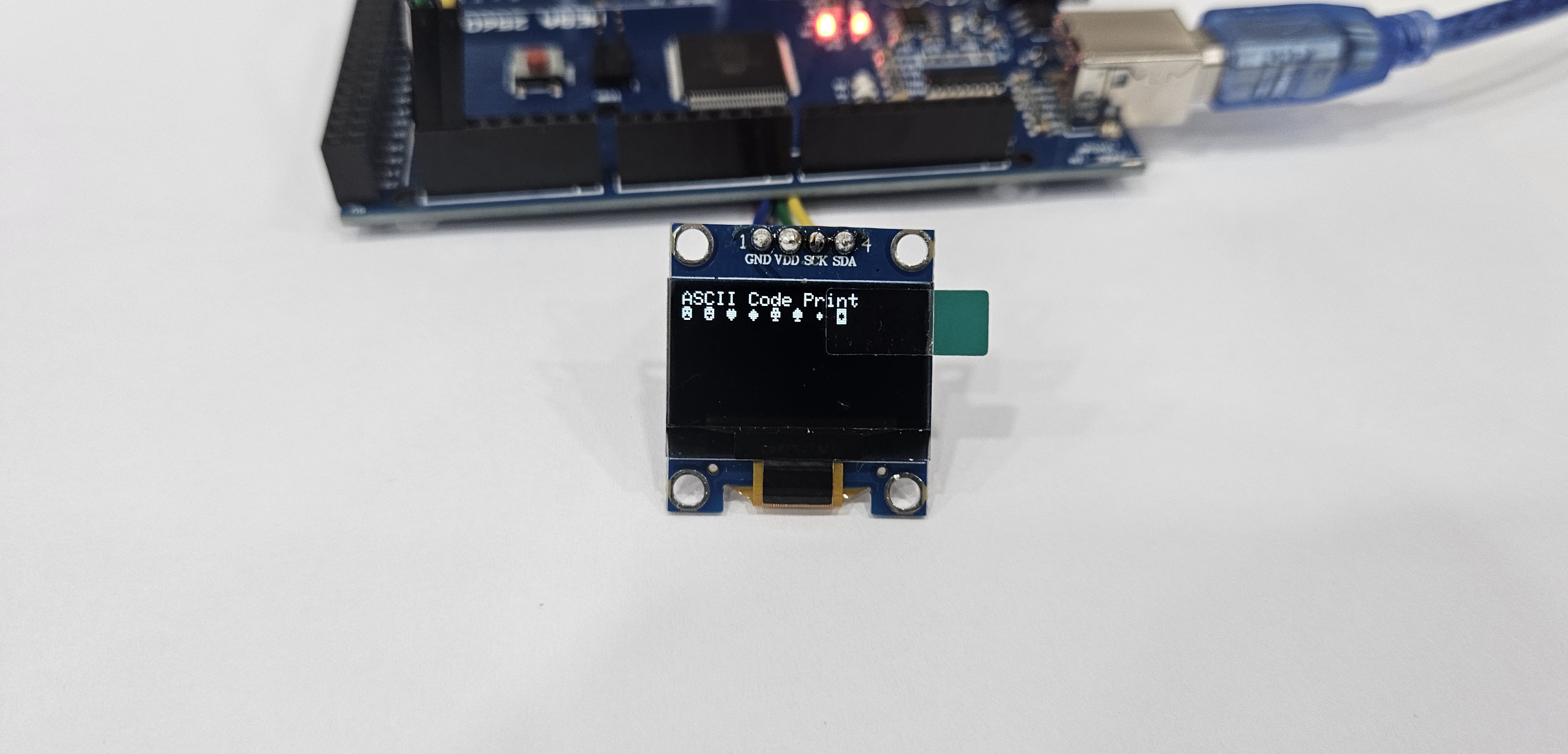
5. Bitmap Image Output
This is an example of outputting an image on the OLED by converting it into a byte array.
How to Convert an Image to a Byte Array
1. Go to image2cpp (javl.github.io).
2. Upload Image
Select a file to upload from the left-side Select image.
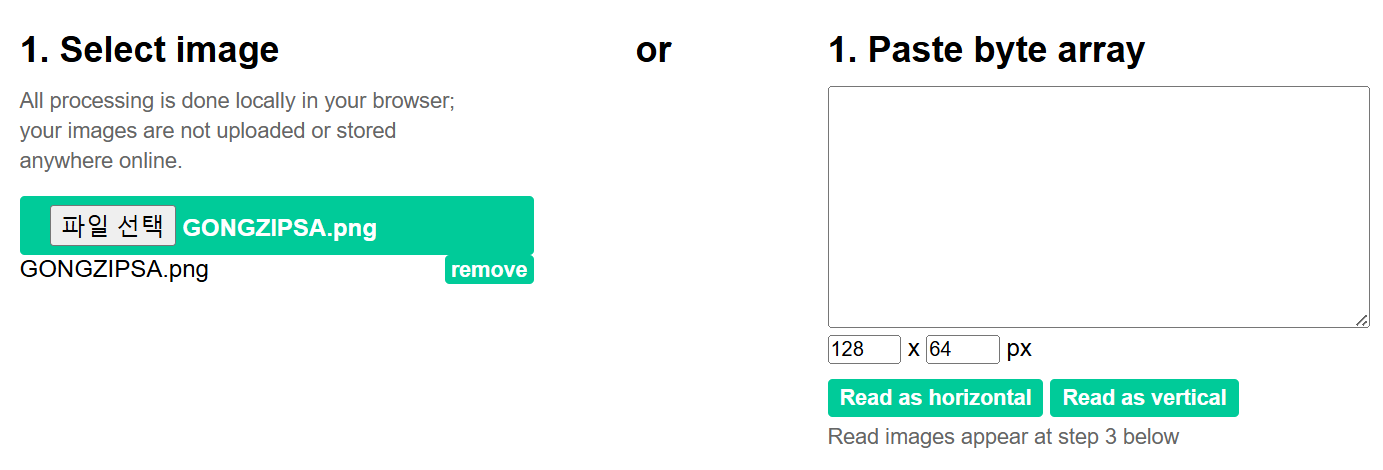
3. Image Settings
Enter the image size in the Canvas size field and check the Preview. If the image is too large and the Canvas size is not properly adjusted, the image may not display correctly in the Preview.
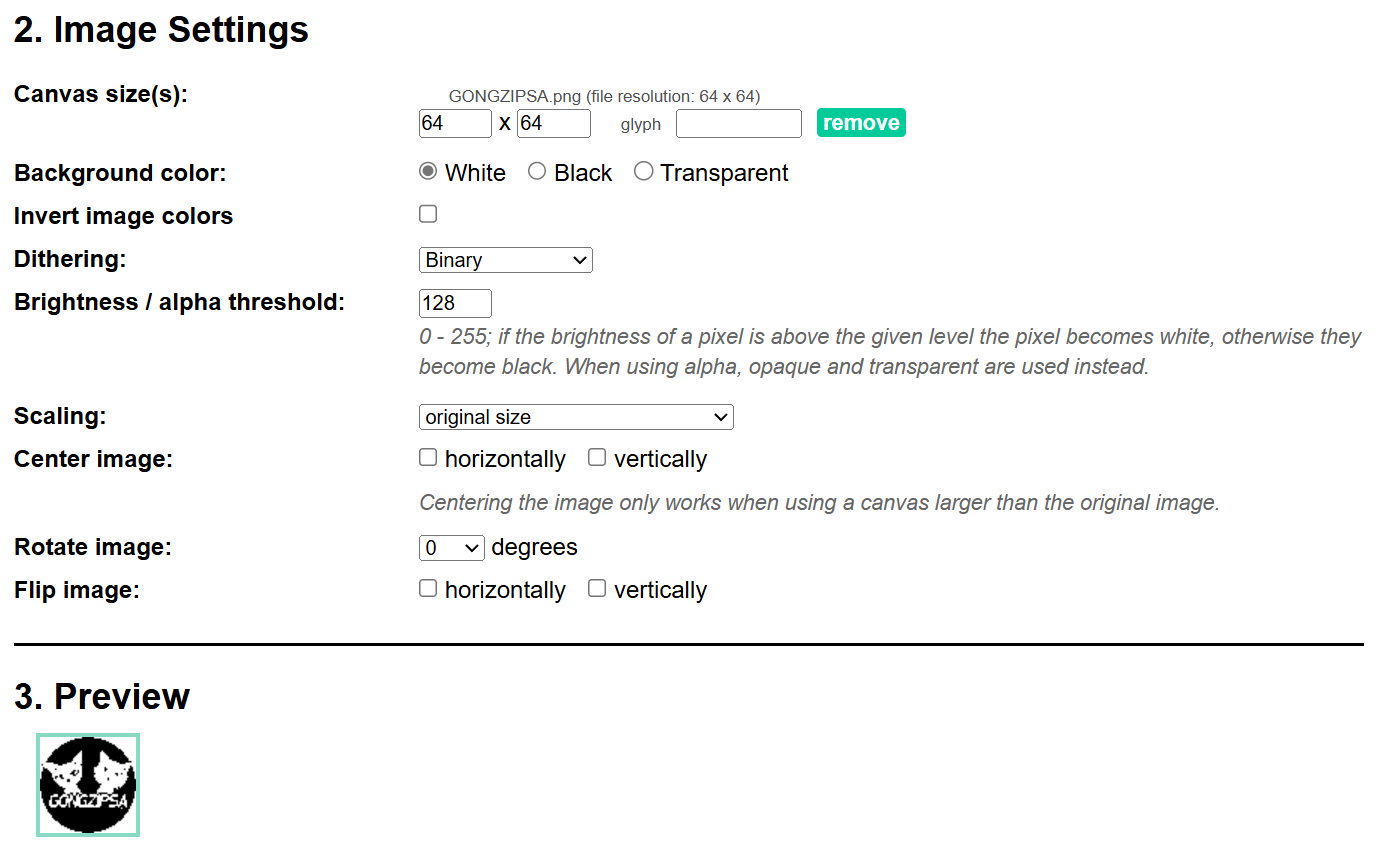
4. Output
Set the Code output format to Arduino Code and click Generate code. The array will be displayed below.
Copy the output array and use it in the example code.
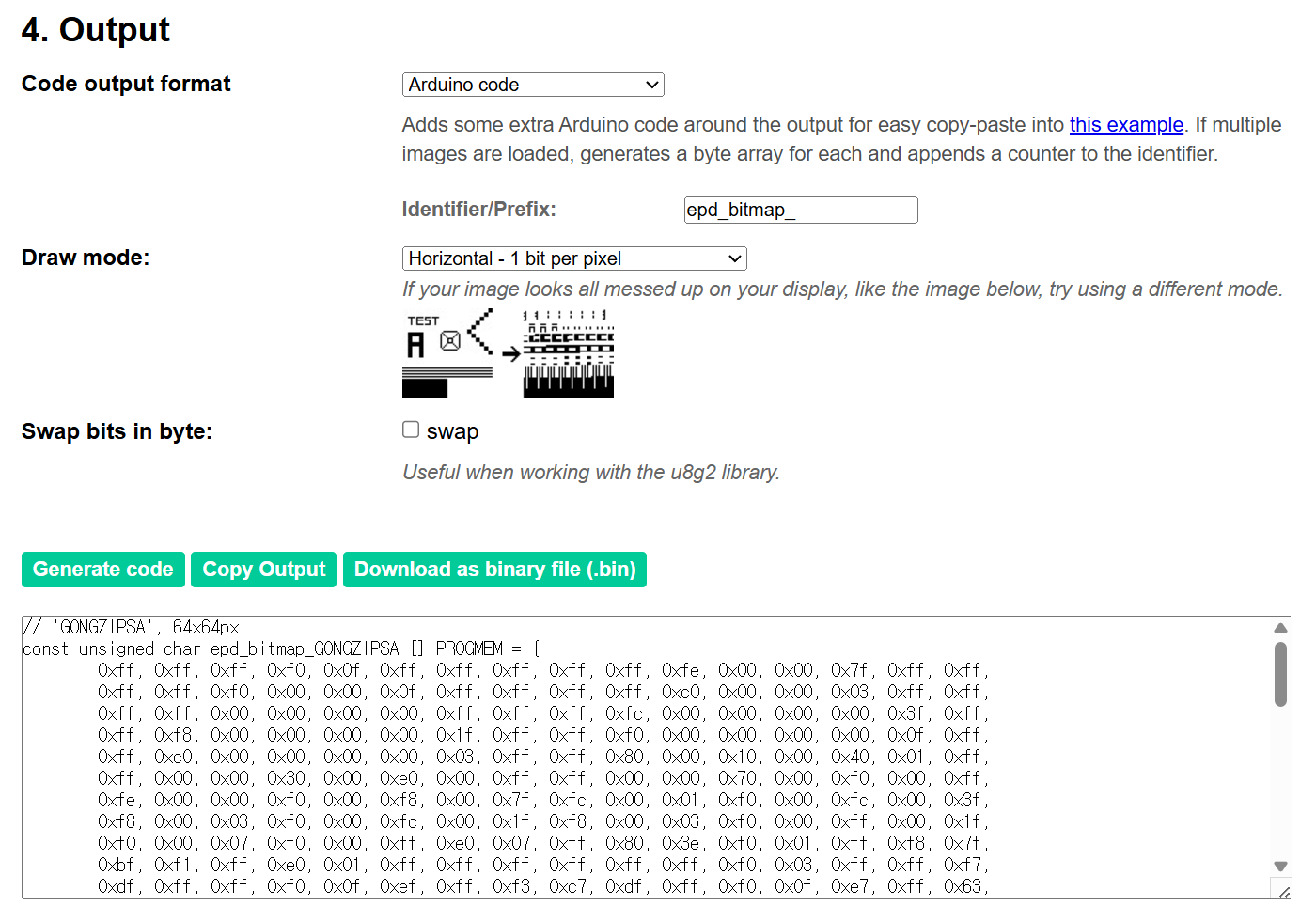
Code
You can use the drawBitmap(x, y, bitmap, width, height, color) function to draw a bitmap image at a specified position.
The color is set to white, so the image will be displayed in white.
Change the const unsigned char ~ part on line 12 to the byte array you created above.
If the example image (64 x 64 size) is different in size, you will need to adjust the x and y cursor positions, as well as the width and height values in the drawBitmap function on line 56 to match the image size.
#include <Wire.h>
#include <Adafruit_GFX.h>
#include <Adafruit_SSD1306.h>
#define SCREEN_WIDTH 128
#define SCREEN_HEIGHT 64
#define OLED_ADDR 0x3C
Adafruit_SSD1306 display(SCREEN_WIDTH, SCREEN_HEIGHT, &Wire, -1);
// GONGZIPSA LOGO
const unsigned char GONGZIPSA [] PROGMEM = {
0xff, 0xff, 0xff, 0xf0, 0x0f, 0xff, 0xff, 0xff, 0xff, 0xff, 0xfe, 0x00, 0x00, 0x7f, 0xff, 0xff,
0xff, 0xff, 0xf0, 0x00, 0x00, 0x0f, 0xff, 0xff, 0xff, 0xff, 0xc0, 0x00, 0x00, 0x03, 0xff, 0xff,
0xff, 0xff, 0x00, 0x00, 0x00, 0x00, 0xff, 0xff, 0xff, 0xfc, 0x00, 0x00, 0x00, 0x00, 0x3f, 0xff,
0xff, 0xf8, 0x00, 0x00, 0x00, 0x00, 0x1f, 0xff, 0xff, 0xf0, 0x00, 0x00, 0x00, 0x00, 0x0f, 0xff,
0xff, 0xc0, 0x00, 0x00, 0x00, 0x00, 0x03, 0xff, 0xff, 0x80, 0x00, 0x10, 0x00, 0x40, 0x01, 0xff,
0xff, 0x00, 0x00, 0x30, 0x00, 0xe0, 0x00, 0xff, 0xff, 0x00, 0x00, 0x70, 0x00, 0xf0, 0x00, 0xff,
0xfe, 0x00, 0x00, 0xf0, 0x00, 0xf8, 0x00, 0x7f, 0xfc, 0x00, 0x01, 0xf0, 0x00, 0xfc, 0x00, 0x3f,
0xf8, 0x00, 0x03, 0xf0, 0x00, 0xfc, 0x00, 0x1f, 0xf8, 0x00, 0x03, 0xf0, 0x00, 0xff, 0x00, 0x1f,
0xf0, 0x00, 0x07, 0xf0, 0x00, 0xff, 0xe0, 0x07, 0xff, 0x80, 0x3e, 0xf0, 0x01, 0xff, 0xf8, 0x7f,
0xbf, 0xf1, 0xff, 0xe0, 0x01, 0xff, 0xff, 0xff, 0xff, 0xff, 0xff, 0xf0, 0x03, 0xff, 0xff, 0xf7,
0xdf, 0xff, 0xff, 0xf0, 0x0f, 0xef, 0xff, 0xf3, 0xc7, 0xdf, 0xff, 0xf0, 0x0f, 0xe7, 0xff, 0x63,
0xc3, 0xff, 0xfc, 0xb0, 0x0f, 0xef, 0xff, 0xe3, 0x81, 0xff, 0xf9, 0xb0, 0x0f, 0xff, 0xff, 0xc1,
0x80, 0xff, 0xf1, 0x70, 0x07, 0xff, 0xcd, 0xc1, 0x80, 0xf9, 0xfc, 0xf0, 0x0f, 0xff, 0xef, 0xc1,
0x80, 0xc9, 0xff, 0xf0, 0x0f, 0xff, 0xff, 0xe1, 0x80, 0x5c, 0xff, 0xe0, 0x07, 0xfb, 0xff, 0xc1,
0x00, 0x7f, 0xcf, 0xe0, 0x07, 0xfb, 0xff, 0xc0, 0x00, 0x3f, 0xcf, 0xc0, 0x03, 0xff, 0xff, 0x80,
0x00, 0x1f, 0xff, 0x80, 0x01, 0xff, 0xff, 0x80, 0x00, 0x0f, 0xff, 0x00, 0x00, 0x7f, 0xff, 0x00,
0x00, 0x07, 0xff, 0x80, 0x00, 0xff, 0xfe, 0x00, 0x00, 0x01, 0xff, 0x80, 0x00, 0xff, 0xf4, 0x00,
0x00, 0x00, 0x7f, 0xc0, 0x01, 0xff, 0x90, 0x00, 0x00, 0x00, 0xff, 0xe0, 0x03, 0xff, 0x80, 0x00,
0x80, 0x00, 0xff, 0xe0, 0x03, 0xff, 0x80, 0x01, 0x80, 0x00, 0x73, 0x30, 0x02, 0x07, 0x00, 0x01,
0x80, 0x71, 0xcb, 0x4e, 0x7d, 0x78, 0xf0, 0x81, 0x81, 0xf3, 0xec, 0xdf, 0x7f, 0xfd, 0xf1, 0x81,
0x81, 0x06, 0x2c, 0xf0, 0x0b, 0xc7, 0x01, 0x81, 0xc1, 0x04, 0x7c, 0xe0, 0x13, 0xcf, 0x83, 0x83,
0xc3, 0x3c, 0x7a, 0xe6, 0x23, 0xf9, 0xf2, 0xc3, 0xc3, 0x1c, 0x73, 0xe2, 0x63, 0x80, 0x16, 0xc3,
0xe3, 0x1c, 0x53, 0xe2, 0xc3, 0x80, 0x17, 0xc7, 0xe3, 0xf7, 0xd1, 0xff, 0xf7, 0x83, 0xfc, 0xc7,
0xf1, 0xe3, 0x91, 0x3f, 0xff, 0x03, 0xc8, 0x4f, 0xf0, 0x00, 0x00, 0x00, 0x00, 0x00, 0x02, 0x0f,
0xf8, 0x00, 0x00, 0x00, 0x00, 0x00, 0x00, 0x1f, 0xf8, 0x00, 0x00, 0x00, 0x00, 0x00, 0x00, 0x1f,
0xfc, 0x00, 0x00, 0x00, 0x00, 0x00, 0x00, 0x3f, 0xfe, 0x00, 0x00, 0x00, 0x00, 0x00, 0x00, 0x7f,
0xff, 0x00, 0x00, 0x00, 0x00, 0x00, 0x00, 0xff, 0xff, 0x00, 0x00, 0x00, 0x00, 0x00, 0x00, 0xff,
0xff, 0x80, 0x00, 0x00, 0x00, 0x00, 0x01, 0xff, 0xff, 0xc0, 0x00, 0x00, 0x00, 0x00, 0x03, 0xff,
0xff, 0xf0, 0x00, 0x00, 0x00, 0x00, 0x0f, 0xff, 0xff, 0xf8, 0x00, 0x00, 0x00, 0x00, 0x1f, 0xff,
0xff, 0xfc, 0x00, 0x00, 0x00, 0x00, 0x3f, 0xff, 0xff, 0xff, 0x00, 0x00, 0x00, 0x00, 0xff, 0xff,
0xff, 0xff, 0xc0, 0x00, 0x00, 0x03, 0xff, 0xff, 0xff, 0xff, 0xf0, 0x00, 0x00, 0x0f, 0xff, 0xff,
0xff, 0xff, 0xfe, 0x00, 0x00, 0x7f, 0xff, 0xff, 0xff, 0xff, 0xff, 0xf0, 0x0f, 0xff, 0xff, 0xff
};
void setup() {
display.begin(SSD1306_SWITCHCAPVCC, OLED_ADDR);
display.clearDisplay(); // Screen initialization
}
void loop() {
display.clearDisplay(); // Clear the screen
// Drawing a 64x64 bitmap image
display.drawBitmap(32, 0, GONGZIPSA, 64, 64, WHITE); // (x, y, bitmap, width, height, color)
display.display(); // Output the buffer contents to the screen
}
Execution Result
Due to flickering, the image appears cut off when captured, but in reality, the round logo is displayed clearly.
